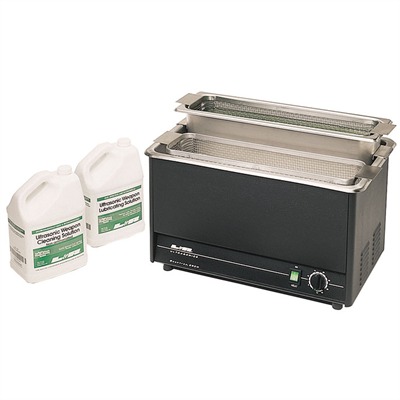Quantrex 650 Ultrasonic Cleaning & Lubrication System Q-650 Gun Cleaning Package
Fast, Hands-Free, Microscopic Cleaning For Dirty Guns & Parts
Add superfast, ultrasonic cleaning to your shop; save yourself a lot of time and make money in the process. 43KHz, Ultrasonic sound waves, plus CA2 Heat create the proven, aggressive action that’s a must for thorough gun cleaning. Incremental, consistent heat along with billions of tiny scrubbing bubbles remove powder fouling, lead and jacketed bullet fouling, light rust, dirt and grease; better, faster and easier than ever before. CA2 Heat eliminates the need to use ammoniated cleaning solutions to remove copper fouling. To clean most firearms, only the most basic field strip is needed. Drop the parts into the basket, turn on the Ultrasonic cleaner and you’re free to do other jobs while the cavitating action in the tank gets everything microscopically clean in as short a time as 7 to 10 minutes. The Gun Cleaning Package used for simultaneous cleaning and lubricating tactical weapons. Includes the Q-650 Ultrasonic Cleaner, Timer and Heater, (1) Q-650 Auxiliary Pan, (2) Q-650 Accessory Baskets, (1) Cover, (4) Gallons, non-ammoniated, L&R Gun Cleaning Concentrate (makes 32 gallons of ready-to-use solution), plus (8) Gallons of L&R Ultrasonic Gun Lubricating Solution (ready-to-use). All the units are heavy duty, built for constant use in a busy shop or department. Not recommended for use with ammoniated solutions.
Input: 117V; 50/60 Hz; 410 Watts
Dimensions: 213⁄4" x 13¾" x 13¼"
Peak Output: 1230 Watts
Tank Dimensions: 19¾" x 11¾" x 6½"
Output Frequency: 42 KHz
Tank Capacity: 23 Quarts
SPECS: Tanks, lids, Accessory Baskets and Auxiliary Pans are stainless steel, outer shell is vinyl-coated steel. Fully transistorized with automatic frequency control, 30 minute timers, pilot lights, drains.Input: 117V; 50/60 Hz; 410 Watts
Dimensions: 213⁄4" x 13¾" x 13¼"
Peak Output: 1230 Watts
Tank Dimensions: 19¾" x 11¾" x 6½"
Output Frequency: 42 KHz
Tank Capacity: 23 Quarts
For this and more L&R Ultrasonic Gun Cleaning Equipment CLICK HERE


